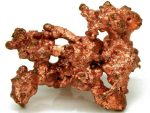Namibia’s economic fortunes in 2025 are set to be heavily influenced by the volatile and increasingly bearish trajectory of global base metal prices, according to a stark analysis by Theo Klein, economist at Oxford Economics Africa. While the country’s mining sector has been a crucial engine for recent growth, deteriorating global trade conditions, fuelled by US protectionist policies, threaten to undermine export earnings and drag real GDP growth down to 3.0% this year, from 3.7% in 2024. The risks, Klein warns, manifest on both the price and quantity fronts, creating a challenging environment for the nation’s key commodity exports.
Global trade tensions, particularly the spectre of US tariffs, have injected significant uncertainty into commodity markets. Although Namibia itself has minimal direct trade exposure to the US – with less than 4% of total exports destined for the American market – the adverse effects are expected to cascade indirectly. Weaker global industrial activity, a direct consequence of disrupted trade flows and heightened uncertainty, will inevitably reduce demand for Namibia’s commodity exports. This indirect channel poses a substantial threat, overshadowing the fact that many Namibian commodities are typically exempt from the initial waves of US tariffs. “Adverse economic effects will be channelled indirectly to Namibia via weaker global industrial activity that will reduce demand for Namibia’s commodity exports,” Klein states, highlighting the pervasive nature of the challenge.
The outlook for base metals, a cornerstone of Namibia’s mining exports, is particularly concerning. Klein notes a distinct “bearish sentiment on base metals in general” following sharp price corrections triggered by the announcement of the “Liberation Day” tariffs. While prices have partially recovered from their lows as the immediate threat of reciprocal tariffs escalated, the fundamental risks remain tilted firmly to the downside. This bearishness is already reflected in contracting manufacturing Purchasing Managers’ Indexes (PMIs) in both China and the US during April, indicating the tariff impact is actively weighing on metal demand. Although recent positive trade talks between the US and China resulted in agreements to lower some tariff rates, Klein cautions that these developments “are not a game changer,” and weak demand growth is still anticipated.
Copper, a critical export, faces specific headwinds. While largely excluded from the initial US 10% baseline tariffs due to its importance for US industry, investigations under Section 232 are underway. Klein anticipates the “red metal will likely be hit next by section 232 tariffs later this year.” Anticipation of these tariffs has already distorted the market, with traders shipping supply into the US, creating a surplus there while depleting inventories elsewhere and artificially tightening global markets to support prices. However, this dynamic is unsustainable. Klein points to weak underlying industrial activity globally and significant increases in copper supply from major producers like the Democratic Republic of Congo (DRC), Peru, Mongolia, and a new mine in Russia. Further expansions in China, Zambia, Chile, and Indonesia are expected to bolster production into 2026. Consequently, Oxford Economics Africa has revised its 2025 London Metal Exchange (LME) copper price forecast down to an average of US$9,197 per tonne.
The picture for other key base metals is similarly subdued. Zinc prices are projected to average US$2,656 per tonne in 2025, as market tightness eases and mining and refining supply recovers. Tin prices might average US$31,827 per tonne, representing a slight downward revision from previous forecasts as disrupted supply begins to improve. “Negative commodity price prospects are expected to weigh on export earnings,” Klein reiterates, directly linking these price declines to Namibia’s revenue stream. The combined effect of potentially lower prices and reduced demand volumes creates a significant drag on the mining sector’s contribution to GDP.
Amidst this base metals gloom, gold offers a relative bright spot. Prices surged dramatically earlier in 2025 but have since pulled back from record highs. Despite pressures from elevated Treasury yields and a strong US dollar, safe-haven demand spurred by volatile US trade policy and a subsequent weakening dollar provided support. Klein maintains a bullish medium-term outlook, underpinned by strong central bank buying, particularly from emerging markets actively diversifying reserves away from the US dollar. “With considerable scope to raise their gold allocations, central banks… present a strong source of potential demand growth,” he notes, highlighting China as a key example where gold still comprises less than 5% of total reserves. Ongoing official purchases suggest sustained support, leading to a forecast average gold price of $3,000 per troy ounce for 2025, a positive factor for Namibian gold producers.
Uranium presents another potential counter-narrative, uniquely benefiting from US policy. President Trump’s executive orders aimed at boosting domestic uranium production, including streamlining regulations and fast-tracking reactor licenses, could buoy prices. “Trump is good for one thing: uranium prices,” Klein observes, suggesting that strong demand coupled with tight short-term supply could lead to price increases, potentially benefiting Namibian uranium operations.
Conversely, the diamond sector, another vital component of Namibia’s economy, continues to face profound structural challenges. Rough and polished diamond exports plummeted in recent periods (-32% and -24% respectively) due to dismal global demand. While Q4 2024 saw a modest recovery in output and Q1 2025 prices stabilized slightly – indicating market efforts to cut production and reduce stockpiles might be having an effect – the outlook remains “bleak.” Klein asserts that “the rise of lab-grown diamonds has caused a permanent structural change in the global diamond market,” a shift compounded by the lingering effects of COVID-19 sales losses. Critically, the US-China trade dispute threatens consumer spending in the world’s top two diamond-consuming nations, making a strong rebound in Namibian diamond output unlikely. Furthermore, US tariffs on key diamond polishing centres like India add another layer of disruption. “A meaningful recovery in natural diamond prices – if there will be one – still far away,” Klein concludes.
The confluence of these factors paints a picture of constrained growth for Namibia. The favourable gold price and potential uranium upside offer some relief, but they are unlikely to fully offset the drag from weakening base metal prices and the ongoing struggles in the diamond sector. “Although growth prospects for non-mining activities remain decent, the gloomy diamond market and weak base metal outlook constrain the short-term economic growth trajectory in Namibia,” Klein summarizes. As global trade uncertainty persists and protectionist measures disrupt supply chains and dampen investment and consumer spending worldwide, Namibia’s export-dependent mining sector finds itself navigating a complex and challenging landscape where the direction of base metal prices will be a decisive factor in determining national earnings this year. The forecast easing of economic growth underscores the tangible impact these global commodity currents are expected to have on the Namibian economy.










